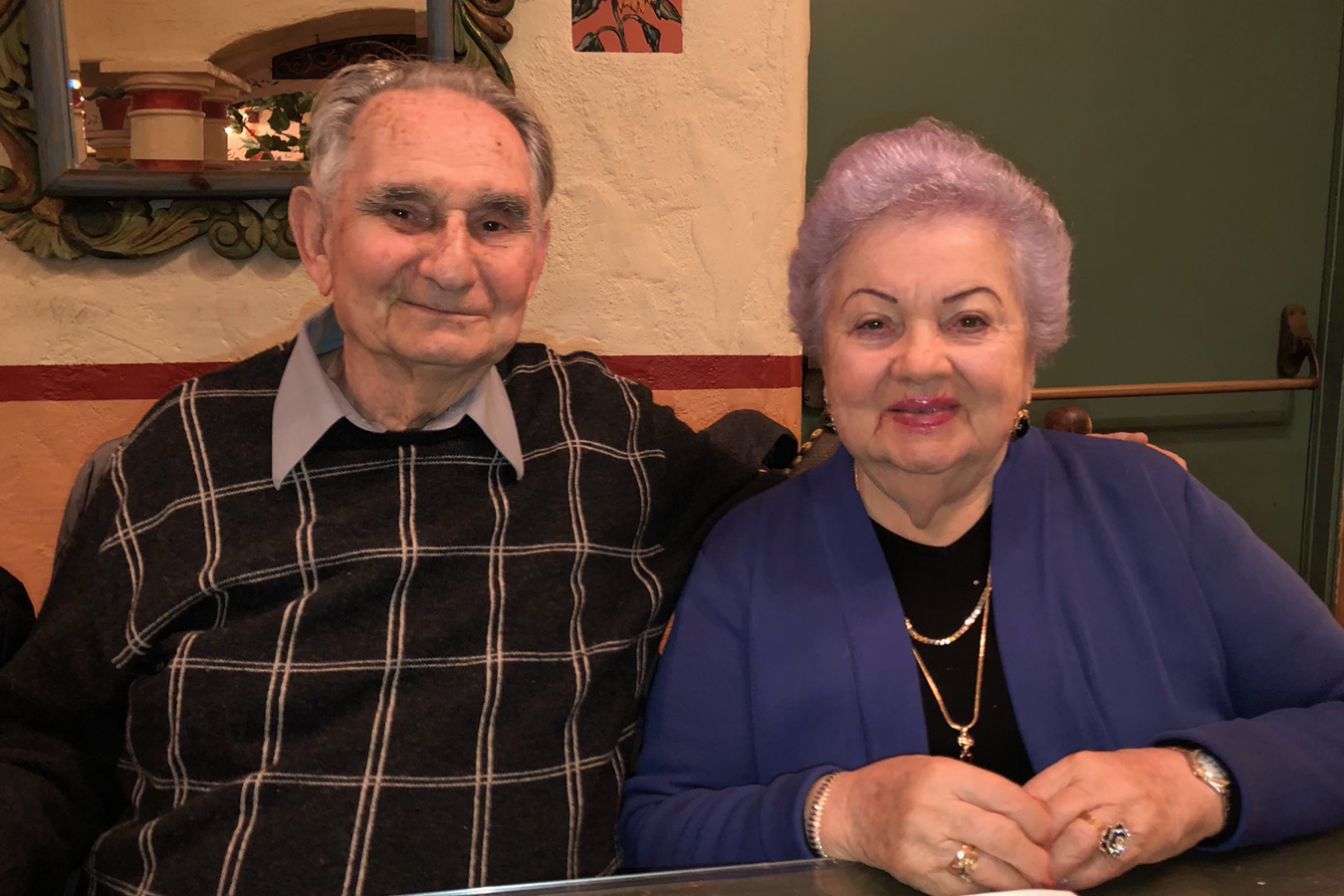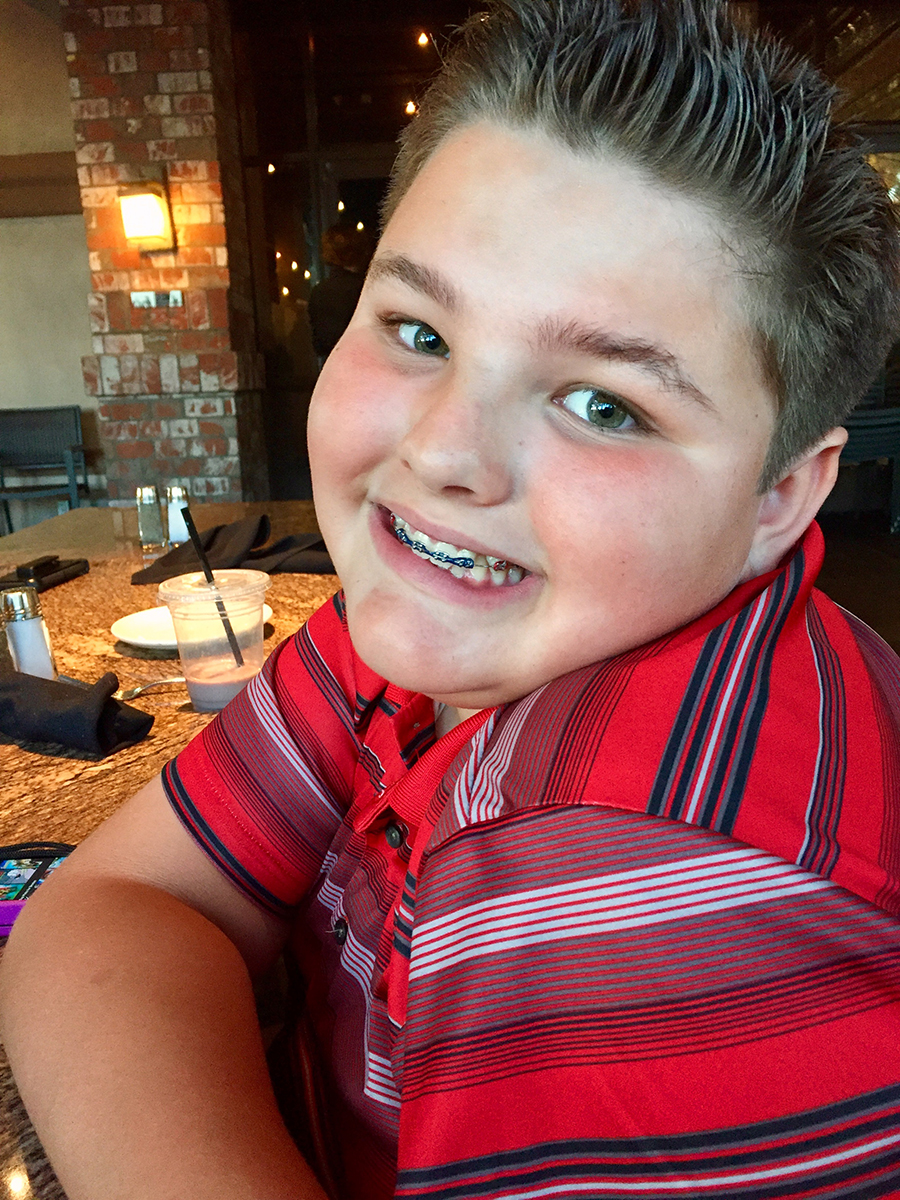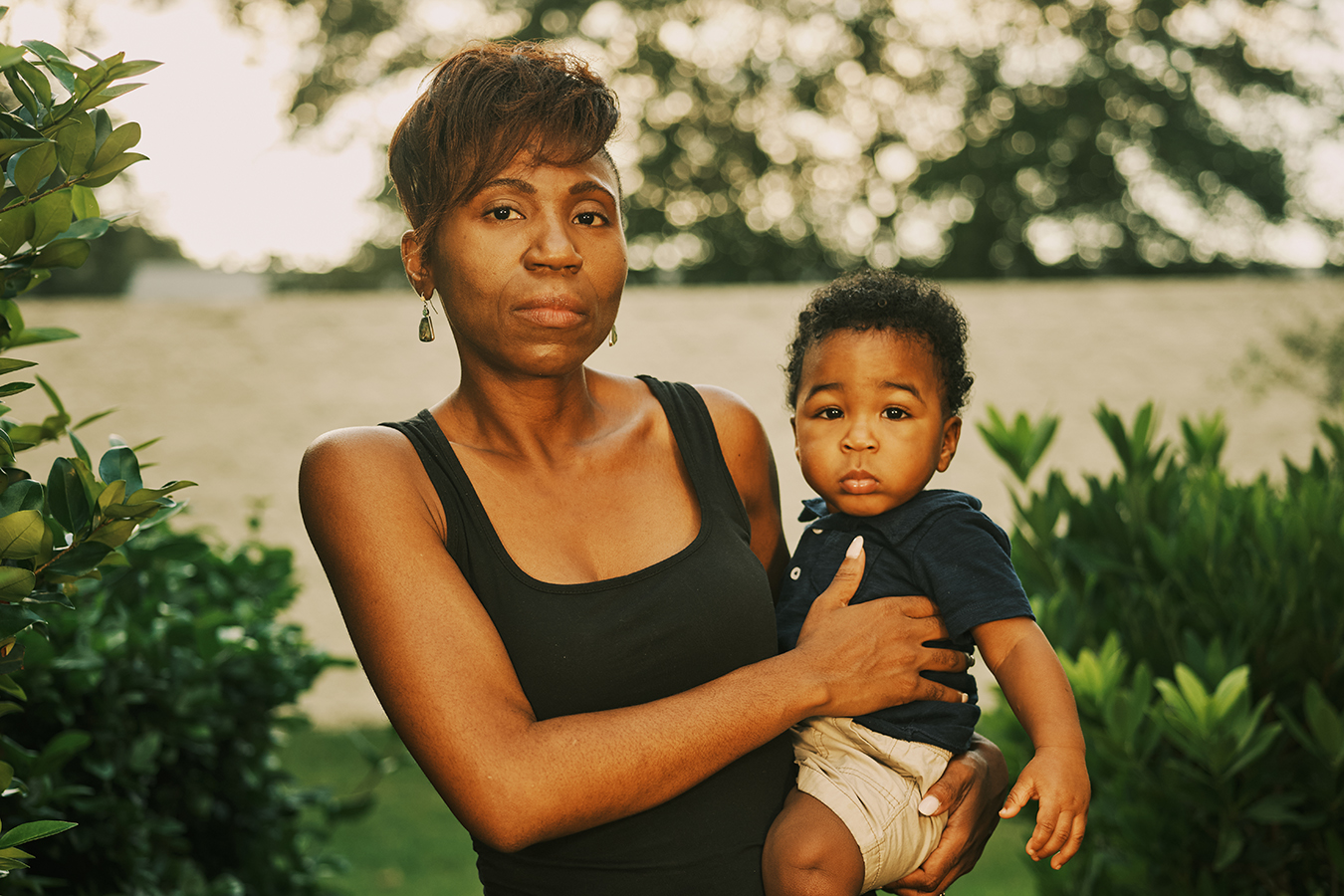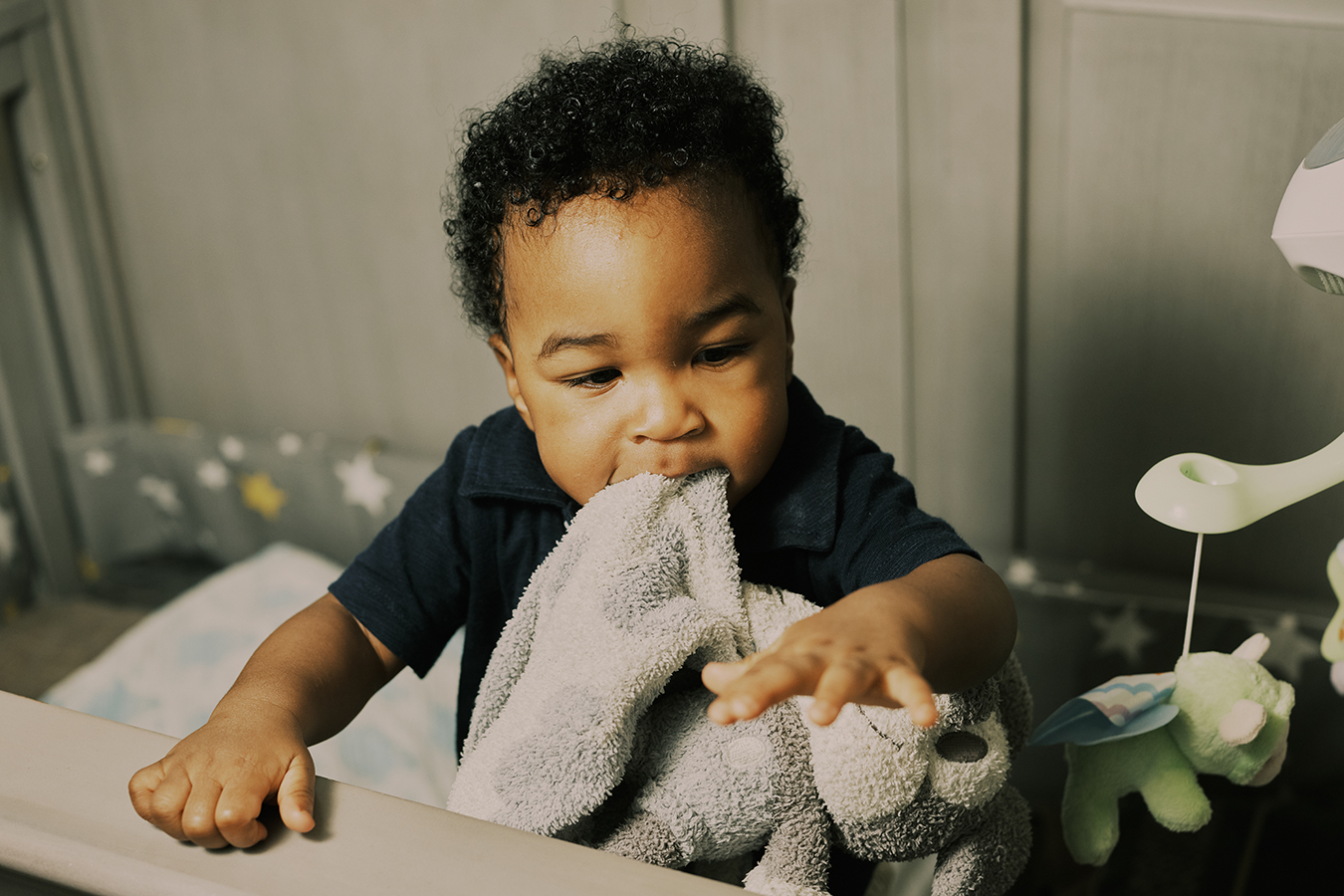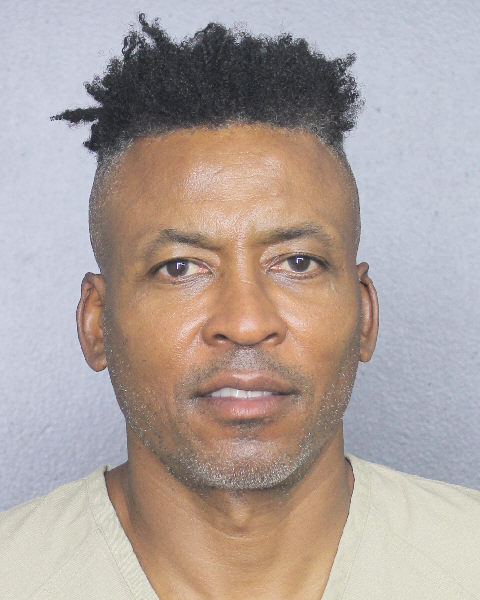One by one, the nurses taking care of actress Judi Evans at Riverside Community Hospital kept calling out sick.
Patients were coughing as staffers wheeled the maskless soap opera star around the California hospital while treating her for injuries from a horseback fall in May 2020, Evans said.
She remembered they took her to a room to remove blood from her compressed lung where another maskless patient was also getting his lung drained. He was crying out that he didn’t want to die of covid.
No one had told her to wear a mask, she said. “It didn’t cross my mind, as I’m in a hospital where you’re supposed to be safe.”
Then, about a week into her hospital stay, she tested positive for covid-19. It left the 57-year-old hospitalized for a month, staring down more than $1 million in bills for treatment costs and suffering from debilitating long-haul symptoms, she said.
Hospitals, like Riverside, with high rates of covid patients who didn’t have the diagnosis when they were admitted have rarely been held accountable due to multiple gaps in government oversight, a KHN investigation has found.
While a federal reporting system closely tracks hospital-acquired infections for MRSA and other bugs, it doesn’t publicly report covid caught in individual hospitals.
Medicare officials, tapped by Congress decades ago to ensure quality care in hospitals, also discovered a gaping hole in their authority as covid spread through the nation. They could not force private accreditors — which almost 90% of hospitals pay for oversight — to do targeted infection-control inspections. That means Riverside and nearly 4,200 other hospitals did not receive those specific covid-focused inspections, according to a government watchdog report, even though Medicare asked accreditors to do them in March 2020.
Seema Verma, former chief of Medicare and Medicaid under President Donald Trump, said government inspectors went into nearly every nursing home last year. That the same couldn’t be done for hospitals reveals a problem. “We didn’t have the authority,” she told KHN. “This is something to be corrected.”
KHN previously reported that at least 10,000 patients nationwide were diagnosed with covid in hospitals last year after being admitted for something else — a sure undercount of the infection’s spread inside hospitals, since that data analysis primarily includes Medicare patients 65 and older.
Nationally, 1.7% of Medicare inpatients were documented as having covid diagnosed after being admitted for another condition, according to data from April through September 2020 that hospitals reported to Medicare. CDIMD, a Nashville-based consulting and data analytics company, analyzed the data for KHN.
At Riverside Community Hospital, 4% of the covid Medicare patients were diagnosed after admission — more than double the national average. At 38 other hospitals, that rate was 5% or higher. All those hospitals are approved by private accreditors, and 29 of them hold “The Gold Seal of Approval” from their accreditor.
To be sure, the data has limitations: It represents a difficult time in the pandemic, when protective gear and tests were scarce and vaccines were not yet available. And it could include community-acquired cases that were slow to show up. But hospital-employed medical coders decide whether a case of covid was present on admission based on doctors’ notes, and are trained to query doctors if it’s unclear. Some institutions fared better than others — while the American public was left in the dark.
Spurred by serious complaints, federal inspectors found infection-control issues in few of those 38 hospitals last year. In Michigan, inspectors reported that one hospital “failed to provide and maintain a sanitary environment resulting in the potential for the spread of infectious disease to 151 served by the facility.” In Rhode Island, inspectors found a hospital “failed to have an effective hospital-wide program for the surveillance and prevention” of covid.
KHN was able to find federal inspection reports documenting infection-control issues for eight of those 38 hospitals. The other 30 hospitals around the country, from Alabama to Arizona, had no publicly available federal records of infection-control problems in 2020.
KHN found that even when state inspectors in California assessed hospitals with high rates of covid diagnosed after admission, they identified few shortcomings.
“The American public thinks someone is watching over them,” said Lisa McGiffert, co-founder of the Patient Safety Action Network, an advocacy group. “Generally they think someone’s in charge and going to make sure bad things don’t happen. Our oversight system in our country is so broken and so untrustworthy.”
The data shows that the problem has deadly consequences: About a fifth of the Medicare covid patients who were diagnosed after admission died. And it was costly as well. In California alone, the total hospital charges for such patients from April through December last year was over $845 million, according to an analysis done for KHN by the California Department of Health Care Access and Information.
The Centers for Disease Control and Prevention has pledged funding for increased infection-control efforts — but that money is not focused on tracking covid’s spread in hospitals. Instead, it will spend $2.1 billion partly to support an existing tracking system for hospital-acquired pathogens such as MRSA and C. diff.
The CDC does not currently track hospital-acquired covid, nor does it plan to do so with the additional funding. That tracking is done by another part of the U.S. Department of Health and Human Services, according to Dr. Arjun Srinivasan, associate director for the CDC’s health care-associated infection-prevention programs. But it’s not made public on a hospital-by-hospital basis. HHS officials did not respond to questions.
The Scene at Riverside
In March 2020, Evans was alarmed by nonstop TV footage of covid deaths, so she and her husband locked down. They hadn’t been going out much, anyway, since losing their only child at the end of 2019 to another public health crisis — fentanyl.
At the time, concerns about covid were mounting among the staff at Riverside Community Hospital, a for-profit HCA Healthcare facility.
The hospital’s highly protective N95 masks had been pulled off the supply room shelves and put in a central office, according to Monique Hernandez, a shop steward for her union, Service Employees International Union Local 121RN. Only nurses who had patients getting aerosol-generating procedures such as intubation — which were believed at the time to spread the virus — could get one, she said.
She said that practice left the nurses on her unit with a difficult choice: either say you had a patient undergoing such procedures or risk getting sick.
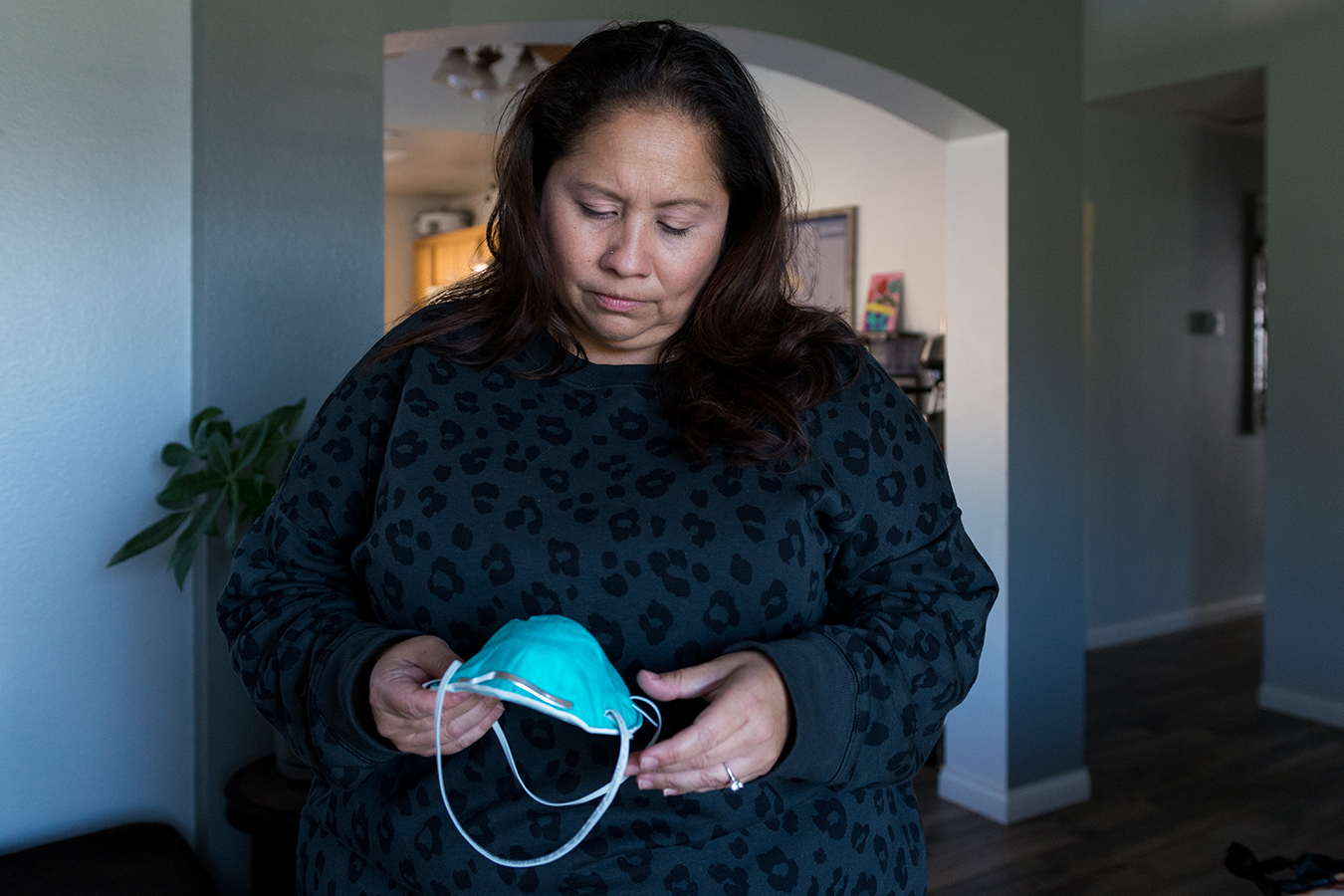
Nurse unions were early adopters of the notion — now widely accepted — that covid is spread by minuscule particles that can linger in the air. Studies since have matched the genetic fingerprint of the virus to show that covid has spread among workers or patients wearing surgical masks instead of more protective masks like N95s.
On April 22, 2020, Hernandez and other nurses joined a silent protest outside the hospital where they held up signs saying “PPE Over Profit.” By that time, the hospital had several staff clusters of infection, according to Hernandez, and she was tired of caregivers being at risk.
In a statement, Riverside spokesperson David Maxfield said the hospital’s top priority has been to protect staff “so they can best care for our patients.”
“Any suggestion otherwise ignores the extensive work, planning and training we have done to ensure the delivery of high-quality care during this pandemic,” he said.
In mid-May, Judi Evans’ husband coaxed her into going horseback riding — one of the few things that brought her joy after her son’s death. On her second day back in the saddle, she was thrown from her horse. She broke her collarbone and seven ribs, and her lung was compressed. She was taken to Riverside Community Hospital.

There, many of her nurses wore masks they had previously used, Evans recalled. Other staffers came in without any masks at all, she said. A few days in, she said, one of the doctors told her it’s crazy that the hospital was testing her for MRSA and other hospital infections but not covid.
Maxfield said that the hospital began enforcing a universal mask mandate for staff and visitors on March 31, 2020, and, “in line with CDC, patients were and are advised to wear masks when outside their room if tolerated.” He stressed “safety of our patients and colleagues has been our top priority.”
After about a week in the hospital, Evans said, she spiked a fever and begged for a covid test. It was positive. There is no way to know for certain where or how she got infected but she believes it was at Riverside. Covid infections can take two to 14 days from exposure to show symptoms like a fever, with the average being four to five days. According to CDC guidance, infection onset that occurs two days or more after admission could be “hospital-associated.”
Doctors told her they might have to amputate her legs when they began to swell uncontrollably, she said.
“It was like being in a horror film — one of those where everything that could go wrong does go wrong,” Evans said.
She left with over $1 million in bills from a month-long stay — and her legs, thankfully. She said she still suffers from long-covid symptoms and is haunted by the screams of fellow patients in the covid ward.
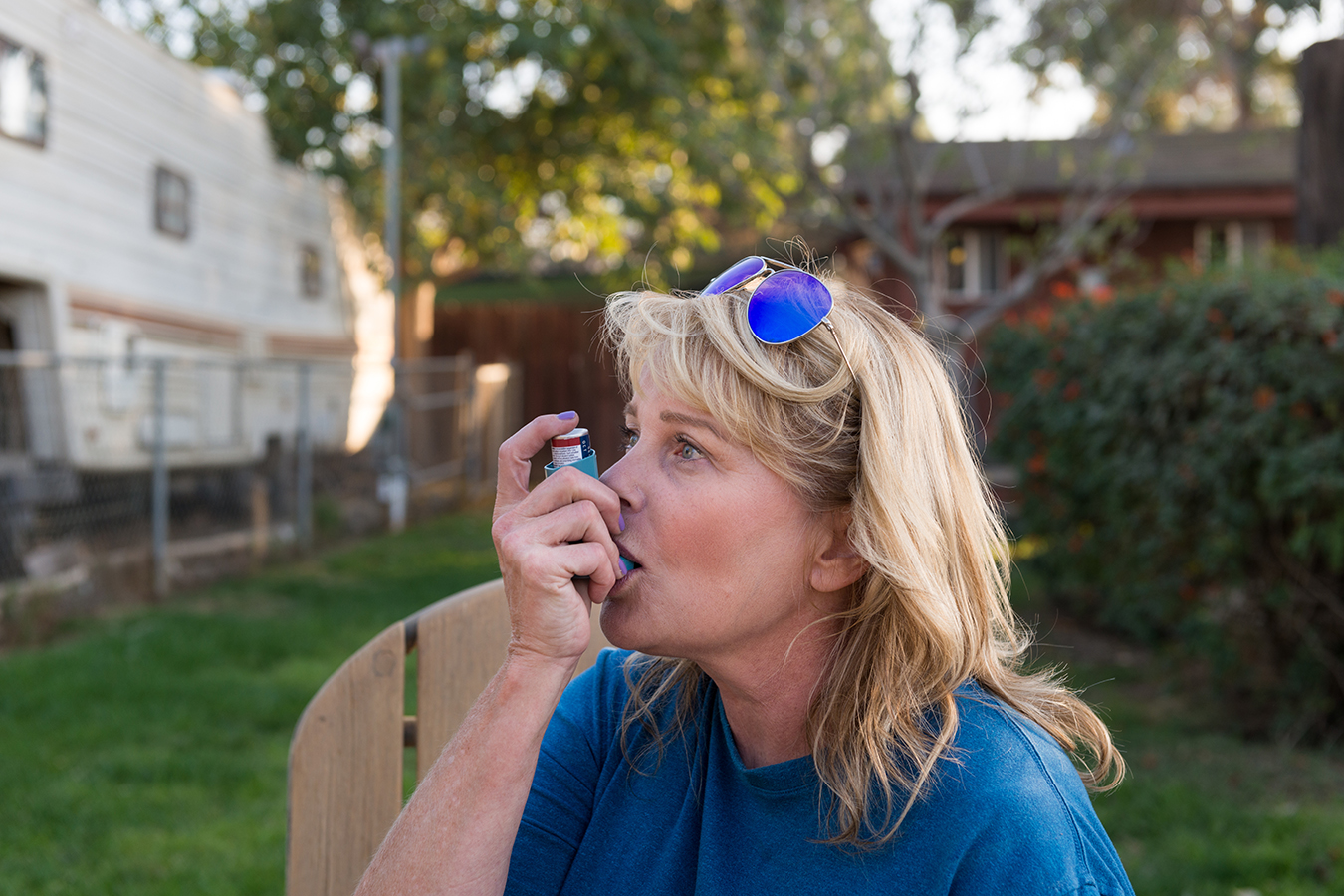
By the end of that year, Riverside Community Hospital would report that 58 of its 1,649 covid patients were diagnosed with the virus after admission, according to state data that covers all payers from April to December.
That’s nearly three times as high as the California average for covid cases not present on admission, according to the analysis for KHN by California health data officials.
“Based on contact tracing, outlined by the CDC and other infectious disease experts, there is no evidence to suggest the risk of transmission at our hospital is different than what you would find at other hospitals,” Maxfield said.
A lawsuit filed in August by the SEIU-United Healthcare Workers West on behalf of the daughter of a hospital lab assistant who died of covid and other hospital staffers says the hospital forced employees to work without adequate protective gear and while sick and “highly contagious.”
The hospital “created an unnecessarily dangerous work environment,” the lawsuit claims, “which in turn has created dangerous conditions for patients” and a “public nuisance.”
Attorneys for Riverside Community Hospital are fighting the ongoing lawsuit. “This lawsuit is an attempt for the union to gain publicity, and we have filed a motion to end it,” said Maxfield, the hospital spokesperson.
The hospital’s lawyers have said the plaintiffs got covid during a spike in local cases and are only speculating that they contracted the virus at the hospital, according to records filed in Riverside County Superior Court.
They also said in legal filings that the court should not step into the place of “government agencies who oversee healthcare and workplace safety” and “handled the response to the pandemic.”

‘A Shortcoming in the Oversight System’
Decades ago, Congress tasked Medicare with ensuring safe, quality care in U.S. hospitals by building in routine government inspections. However, hospitals can opt to pay up to tens of thousands of dollars per year to nongovernmental accreditors entrusted by CMS to certify the hospitals as safe. So 90% do just that.
But these accrediting agencies — including the Joint Commission, which certified Riverside — are private organizations. Thus they are not required to follow CMS’ directives, including the request in a March 20 memo urging the accrediting agencies to execute targeted infection-control surveys aimed at preparing hospitals for covid’s onslaught.
And so they didn’t send staffers to survey hospitals for the specialized infection-control inspections in 2020, according to a June 2021 Health and Human Services Office of the Inspector General report.
Riverside, despite allegations of lax practices, holds The Gold Seal of Approval from the Joint Commission, which last inspected the hospital on-site in May 2018 before going in on Nov. 19 this year.
The inspector general’s office urged CMS to pursue the authority to require special surveys in a health emergency — lest it lose control of its mission to keep hospitals safe.
“CMS could not ensure that accredited hospitals would continue to provide quality care and operate safely during the COVID-19 emergency,” and could not ensure it going forward, the report said.
“We’re telling CMS to do their job,” the report’s author, Assistant Regional Inspector General Calvin Jones, said in an interview. “The covid experience really showed a shortcoming in the oversight system.”
CMS spokesperson Raymond Thorn said the agency agrees with the report’s recommendation and will work on a regulation after the public health emergency ends.
Accrediting agencies, however, pushed back on the inspector general’s findings. Among them: DNV Healthcare USA Inc. Its director of accreditation, Troy McCann, said there was not a gap in oversight. Although he said travel restrictions limited accreditors ability to fly across state lines, his group continued its annual reviews after May 2020 and incorporated the special focus on infection control into them. “We have a strong emphasis, always, on safety, infection control and emergency preparedness, which has left our hospitals stronger,” McCann said.
Angela FitzSimmons, spokesperson for the Accreditation Commission for Health Care, said that the accrediting organization’s surveys typically focus on infection control, and the group worked during the pandemic to prioritize hospitals with prior issues in the area of infection prevention.
“We did not deem it necessary to add random surveys that would occur at a cost to the hospital without just cause,” FitzSimmons said.
Maureen Lyons, a spokesperson for the Joint Commission, told KHN that, after evaluating CMS guidance, the nonprofit group decided it would incorporate the infection-control surveys into its surveys done every three years and, in the meantime, provide hospitals with the latest federal guidance on covid.
“Hospitals were operating in extremis. Thus, we collaborated closely with CMS to determine optimal strategies during this time of emergency,” she said.
The Joint Commission cited safety issues for its inspectors, who travel to the hospitals and need proper protective equipment that was running low at the time, as part of the reason for its decision.
Verma, the CMS administrator at the time, pushed back on accreditors’ travel safety concerns, saying that “narrative doesn’t quite fit because the state and CMS surveyors were going into nursing homes.”
Though Verma cautioned that hospitals were overwhelmed by the crush of covid patients, “doing these inspections may have helped hospitals bolster their infection-control practices,” she said. “Without these surveys, we really have no way of knowing.”
‘Immediate Jeopardy’
Medicare inspectors can go into a privately accredited hospital after they get a serious complaint. They found alarming circumstances when they visited some of the hospitals with high rates of covid diagnosed after a patient was admitted for another concern last year.
At Levindale Hebrew Geriatric Center and Hospital in Baltimore, the July 2020 inspection report says “systemic failures left the hospital and all of its patients, staff, and visitors vulnerable to harm and possible death from COVID-19.”
In response, hospital spokesperson Sharon Boston said that “we have seen a large decrease in the spread of the virus at Levindale.”
Inspectors had declared a state of “immediate jeopardy” after they investigated a complaint and discovered an outbreak that began in April and continued through the beginning of July, with more than 120 patients and employees infected with covid. And in a unit for those with Alzheimer’s and other conditions, 20% of the 55 patients who had covid died.
The hospital moved patients whose roommates tested positive for covid to other shared rooms, “potentially exposing their new roommate,” the inspection report said. Boston said that was an “isolated” incident and the situation was corrected the next day, with new policies put in place.
The Medicare data analyzed exclusively for KHN shows that 52 of Levindale’s 64 covid hospital patients, or 81%, were diagnosed with covid after admission from April to September 2020. Boston cited different numbers over a different time period: Of 67 covid patients, 64 had what she called “hospital-acquired” covid from March to June 2020. That would be nearly 96%.
The hospital shares space with a nursing home, though, so KHN did not group it with the general short-term acute-care hospitals as part of the analysis. Levindale’s last Joint Commission on-site survey was in December 2018, resulting in The Gold Seal of Approval. It had not had its once-every-three-years survey as of Dec. 10, 2021, according to the Joint Commission’s tracking.
Boston said Levindale “quickly addressed” the issues that Medicare inspectors cited, increasing patient testing and more recently mandating staff vaccines. Since December 2020, Boston said, the facility has not had a covid patient die.
At the state level, hospital inspectors in California found few problems to cite even at hospitals where 5% or more patients were diagnosed with covid after they were admitted for another concern. Fifty-three complaints about such hospitals went to the Department of Public Health from April until the end of 2020. Only three of those complaints resulted in a finding of deficiency that facility was expected to fix.
CDPH did not respond to requests for comment.
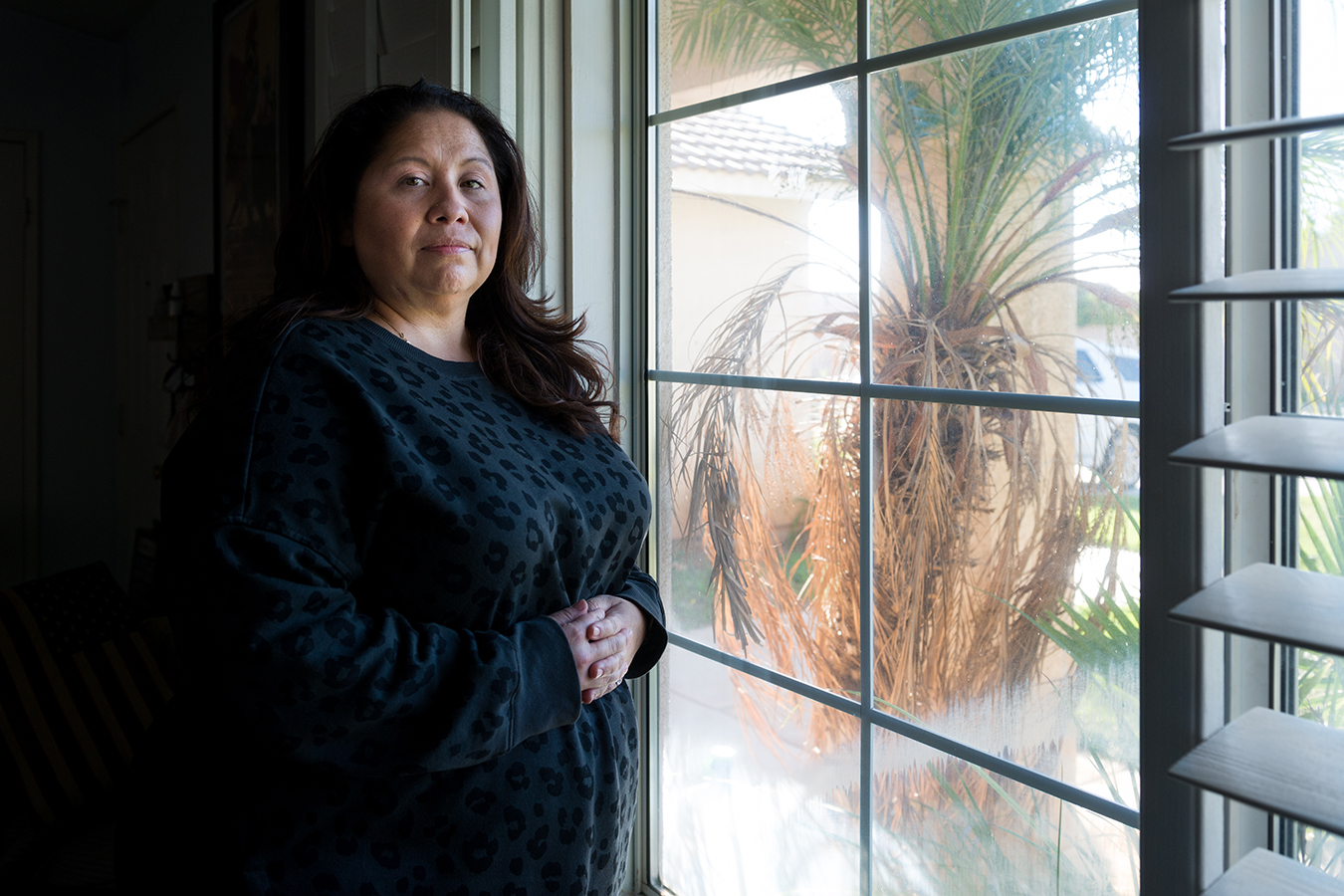
A New Chapter
Things are better now at Riverside Community Hospital, Hernandez said. She is pleased with the current safety practices, including more protective gear and HEPA filters for covid patients’ rooms. For Hernandez, though, it all comes too late now.
“We laugh at it,” she said, “but it hurts your soul.”
Evans said she was able to negotiate her $1 million-plus hospital bills down to roughly $70,000.
Her covid aftereffects have been ongoing — she said she stopped gasping for air and reaching for her at-home oxygen tank only a few months ago. She still hasn’t been able to return to work full time, she said.
For the past year, her husband would wake up in the middle of the night to check whether her oxygen levels were dipping. Terrified of losing her, he’d slip an oxygen mask on her face, she said.
“I would walk 1,000 miles to go to another hospital,” Evans said, if she could do it all over again. “I would never step foot in that hospital again.”
Methodology
KHN requested custom analyses of Medicare, California and Florida inpatient hospital data to examine the number of covid-19 cases diagnosed after a patient’s admission.
The Medicare and Medicare Advantage data, which includes patients who are 65 and older, is from the Centers for Medicare & Medicaid Services’ Medicare Provider Analysis and Review (MedPAR) file and was analyzed by CDIMD, a Nashville-based medical code consulting and data analytics firm. The data is from April 1 through Sept. 30, 2020. The data for the fourth quarter of 2020 was not yet available.
The data shows the number of inpatient Medicare hospital stays in the U.S., including the number of people diagnosed with covid-19 and the number of admissions for which the covid diagnosis was not “present on admission.” CMS considers some medical conditions that are not “present on admission” to be hospital-acquired, according to the agency. The data is for general acute-care hospitals, which may include a psychiatric floor, and not for other hospitals such as those in the Department of Veterans Affairs system or stand-alone psychiatric hospitals.
KHN requested a similar analysis from California’s Department of Health Care Access and Information of its hospital inpatient data. That data was from April 1 through Dec. 31, 2020, and covered patients of all ages and payer types and, in general, private psychiatric and long-term acute-care hospitals. Etienne Pracht, a University of South Florida researcher, provided the number of Florida covid patients who did not have the virus upon hospital admission for all ages and payer types at general and psychiatric hospitals from April 1 through Dec. 31, 2020. KHN subtracted the number of Medicare patients in the MedPAR data from the Florida and California datasets so they would not be counted twice.
To calculate the rate of hospitalized Medicare patients who tested positive for covid — and died — KHN relied on the MedPAR data for April through September. That data includes records for 6,629 seniors, 1,409 of whom, or 21%, died. California data for all ages and payer types from April through December shows a similar rate: Of 2,115 diagnosed with covid-19 after hospital admission, 435, or 21%, died. The MedPAR data was also used to calculate the national rate of 1.7%, with 6,629 of 394,939 covid patients diagnosed with the virus whose infections were deemed not present on admission, according to the CDIMD analysis of data that hospitals report to Medicare. It was also used to calculate which entities licensed as short-term acute care hospitals had 5% or more of their covid cases diagnosed within the hospital. As stated in the story, Levindale Hebrew Geriatric Center and Hospital in Baltimore was not included in that list of 38 because it shares space with a nursing home and had fewer than 500 total discharges.
Data that hospitals submit to Medicare on whether an inpatient hospital diagnosis was “present on admission” is used by Medicare for payment determinations and is intended to incentivize hospitals to prevent infections during hospital care. The federal Agency for Healthcare Research and Quality also uses the data to “assist in identifying quality of care issues.”
Whether covid-19 is acquired in a hospital or in the community is measured in different ways. Some nations assume the virus is hospital-acquired if it is diagnosed seven or more days after admission, while U.S. data counts cases only after 14 days.
Hospitals’ medical coders who examined patient records for the data analyzed for this KHN report focus on each physician’s admission, progress and discharge notes to determine whether covid was “present on admission.” They do not have a set number of days they look for and are trained to query physicians if the case is unclear, according to Sue Bowman, senior director of coding policy and compliance at the American Health Information Management Association.
KHN tallied the cases in which covid-19 was logged in the data as not “present on admission” to the hospital. Some covid cases are coded as “U” for having insufficient documentation to make a determination. Since Medicare and AHRQ consider the “U” to be an “N” (or not present on admission) for the purposes of payment decisions and quality indicators, KHN chose to count those cases in the grand total.
In 409 of 6,629 Medicare cases and in 70 of 2,185 California cases, the “present on admission” indicator was “U.” The Florida data did not include patients whose “present on admission” indicator was “U.” Medical coders have another code, “W,” for “clinically undetermined” cases, which consider a condition present on admission for billing or quality measures. Medical coders use the “U” (leaning toward “not present on admission”) and “W” (leaning toward “present on admission”) when there is some uncertainty about the case. KHN did not count “W” cases.
The Medicare MedPAR data includes about 2,500 U.S. hospitals that had at least a dozen covid-19 cases from April through September 2020. Of those, 1,070 reported no cases of covid diagnosed after admission for other conditions in the Medicare records. Data was suppressed due to privacy reasons for about 1,300 hospitals that had between one and 11 of such covid cases. There were 126 hospitals reporting 12 or more cases of covid that were “not present on admission” or unknown. For those, we divided the number of cases diagnosed after admission by the total number of patients with covid to arrive at the rate, as is standard in health care.
Inspection and Accreditation Analysis
To evaluate which of the 38 hospitals detailed above had federal inspection reports documenting infection-control issues, KHN searched CMS’ publicly available “2567” reports, which detail deficiencies for each hospital for 2020. For surveys listed online as “not available,” KHN requested and obtained them from CMS. KHN further asked CMS to double-check the remaining hospitals for any inspection reports that weren’t posted online. KHN also checked the Association of Health Care Journalists’ database http://www.hospitalinspections.org/ for each of the 38 hospitals for any additional reports, as well as CMS’ Quality, Certification and Oversight Reports site.
To check that each of these hospitals was accredited, KHN looked up each hospital using a site run by the Joint Commission and reached out to the accreditors DNV Healthcare USA Inc. and the Accreditation Commission for Health Care.
To tabulate infection-control complaints for hospitals at the state level in California, KHN used data available through the California Department of Public Health’s Cal Health Find Database. KHN searched the database for the hospitals that had higher than 5% of covid patients being diagnosed after admission, according to the California data, and tallied all complaints and deficiencies found involving infection control from April to December 2020.
KHN (Kaiser Health News) is a national newsroom that produces in-depth journalism about health issues. Together with Policy Analysis and Polling, KHN is one of the three major operating programs at KFF (Kaiser Family Foundation). KFF is an endowed nonprofit organization providing information on health issues to the nation.
USE OUR CONTENT
This story can be republished for free (details).
from Health Industry – Kaiser Health News
